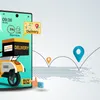A basic meaning of hyperlocal economy is ‘a company and its activities are restricted to the very same geographical location’. A hyperlocal economy consists of all mommy and pop stores, regional haats, and veggie markets. The modified meaning, on the other hand, has extra functions. GPS places and mobile applications are progressively utilized to handle retail and circulation.
The COVID-19 break out has actually modified the method and the market India Inc operates. The entire retail landscape has actually moved far from shopping centers and towards the hyperlocal market and ecommerce rapidly. As the economy weakened throughout the numerous lockdowns, business started to depend on in your area readily available items or resources to fulfill need.
As an outcome, everybody from customers to services aspires to utilize hyperlocal channels to endure. One such example is Zomato and Swiggy, who ventured into grocery shipment in cooperation with area kirana shops to please customer need.
Projections and early patterns
There was a term paper assembled by Affle’’ s MAAS, a combined mobile marketing platform, and Sensor Tower (a US-based mobile app shop marketing intelligence business). They collectively studied the essential elements that sped up e-commerce adoption in India and Southeast Asia in the current past, and how COVID-19 has actually formed shopping behaviour.
According to this research study, the Indian ecommerce sector would broaden by approximately 84 percent in the next 4 years, mainly sustained by the need created throughout the shutdown. According to a Google search research study, the year 2020 saw an 8X increase in online look for ‘stores near me,’ a 60 percent boost in look for house shipment, and a 60 percent boost in look for ‘how to pay online.’
There is likewise a shift in how individuals negotiate, with digital wallets surpassing credit and debit cards as the most typical payment technique in 2020. Ecommerce has actually changed in-store buying as the favored technique for business of all sizes.
Given growing web penetration and smart device usage, the online acquiring pattern will just speed up in the coming years. Purchasers in Tier II and III cities relied on online orders and payment techniques. Customers throughout the board have actually ended up being mindful of the requirement for contactless shipment to decrease the risk of infection.
The hyperlocal market in India has actually been mainly driven by a boost in the variety of customers and start-ups’ “on-demand shipment choice”. Hyperlocal business in India utilize a versatile application to work together with merchants and customers as an organization technique. In India, hyperlocal business are mostly backed by innovation and have actually effectively linked various regional stores with customers in the Hyperlocal market. When companies like Domino’s and Pizza Hut started using food shipment, #peeee
The last time the hyperlocal market in India grew was. More dining establishments started to supply house shipment. The years 2014 to 2016 were the peak of hyperlocal culture in India, with brand-new companies such as Zomato, Swiggy, and Foodpanda taking control.
.READ. [Techie Tuesday] How emerging innovations assist hyperlocal circulation environment..What does it provide for brands?Hyperlocal assists brand names with growth –– considered that every area has its own flavour of hyperlocal, it can assist construct much better market penetration through these cooperations, than needing to purchase a whole go to market device for each market.
[Techie Tuesday] How emerging innovations assist hyperlocal circulation environment..What does it provide for brands?Hyperlocal assists brand names with growth –– considered that every area has its own flavour of hyperlocal, it can assist construct much better market penetration through these cooperations, than needing to purchase a whole go to market device for each market.
This supplies a terrific branding platform, a shipment platform, an end-to-end logistic platform, and an ideal chance to obtain a brand-new customer base, engage with them –– with no of the trouble related to needing to roll this out separately. Having an existence on these platforms likewise supplies brand names with awareness on competitors and techniques released within those particular markets.
Aside from the reach, hyperlocal marketing has the capacity for excellent roi. Brand names might get their name in front of their target market —– the people who can drive into their shops the exact same day –– by sponsoring regional occasions or using regional influencers in their social networks material.
Additionally, hyperlocal digital marketing help in the collection of online evaluations, which might improve the brand name’s regional rankings even further.
Google’s vibrant digital environment, localised web directory sites, social networks, and mobile marketing allow business to rapidly communicate with clients in particular places and engage with regional business on a formerly hidden level.
For a lot of small companies, it’s a rational action, as the volume of service they carry out with innovation partners, carriers, providers, and product packaging providers are not likely to get the economies of scale that a full-service third-party supplier can provide a single company.
If they do it themselves, they will not have the ability to get the very best rates for web servers, scams avoidance, payment processing, web designers, tax services, packaging, shipping, and warehousing. If it is contracted out to a partner, regional contacts and dedicated, skilled personnel will considerably help the little organisation.
Opportunity for brand names? Scalability?
Despite the entry of various brand-new business, increasing earnings levels, increasing aspirations, beneficial demographics, and inexpensive credit accessibility have actually sped up and pressed the Indian retail market to become among the most fast-growing and vibrant markets.
The online retail sector has actually been considered the next-generation design with outstanding development capacity for future growth. Sellers are making every effort to endeavor into e-retailing to utilize digital retail channels to connect to more customers in Tier II and III cities (ecommerce). It shows that they require to invest less cash in realty. In India, ecommerce is considered among the fastest broadening industrial deal channels.
With the addition of payment and marketing possibilities offered in our instant distance, the term “hyper-local commerce” is created. While the expression appears to have actually acquired appeal in 2015, it is not a brand-new concept.
The quick development of Internet users, the growth of payment options, the expansion of geo-location-aware devices, and the increasing desire for immediate shipment have actually all prepared the method for hyperlocal business in India.
Of course, for clients, this seems like an extension of the tech-powered benefit they’ve grown familiar with. They might delight in doorstep shipment of things that are often needed instantly, such as groceries, prescriptions, laundry, meals, and so on.
With the Chi-Square Test and Binary Logistics Regression, this research study concentrates on embracing and welcoming hyperlocal method in Indian e-Retailing business to bridge the space in between online and offline shops and change the face of Indian retail.
Closing ideas
Despite the different great elements of the hyperlocal environment, the sector likewise provides some difficulties. As an outcome, while the hyperlocal design appears simple in concept, it is much more complex to execute in practice. Monitoring stock with regional merchants is among the most difficult problems a hyperlocal company might come across.
The hyperlocal market design is vital in India not simply for consumers however likewise for the market’s stability. The whole public might benefit significantly from this method.
The typical individual is restricted to his/her home. They are having problem doing their day-to-day shopping. As an outcome, a retail service that offers hyperlocal services can be very helpful to the basic population.
Edited by Saheli Sen Gupta
( Disclaimer: The viewpoints and views revealed in this short article are those of the author and do not always show the views of YourStory.)
.
Read more: yourstory.com

















